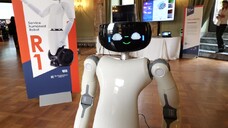The robot, which is equipped with artificial intelligence and real physiological reactions, has been installed in the centre for medical simulation and advanced training of the hospital of Cattinara. Produced by the Accurate-Gaumard Scientific company, it will be used to boost and fine-tune the training of doctors.
Hal s5301 is run by a control room: it talks, sweats, and moves its eyes and arms and is structured to enable the practice of the main applied medical technical techniques in emergency care, intensive care and surgery. The robot reproduces the cardiac, respiratory, vascular and cerebro-vascolar physiology that can be examined using the tools used in clinical practice.
It thus becomes possible to simulate hospital activity upon the arrival of a patient, throwing up diverse clinical cases proposed by the teachers: by observing Hal s5301 and his symptoms, they formulate their diagnosis and act on it. At the end comes the debriefing, led by the doctors.
“For the first time AI has been integrated into a humanoid simulator in medicine,” explained Patrizia Angelotti, managing director of Accurate, ”and the social applications of advanced interdisciplinary training will be widely used in the reduction of errors in medicine due to the human factor".
Riproduzione riservata © Copyright ANSA













